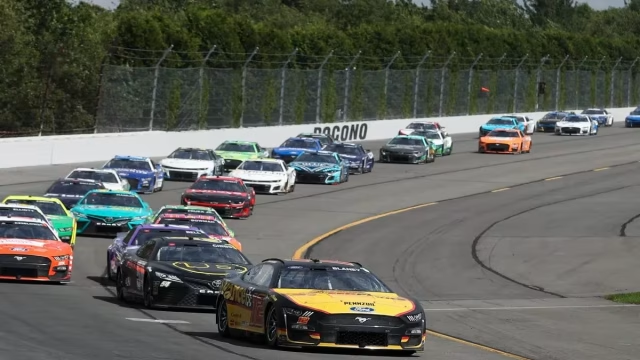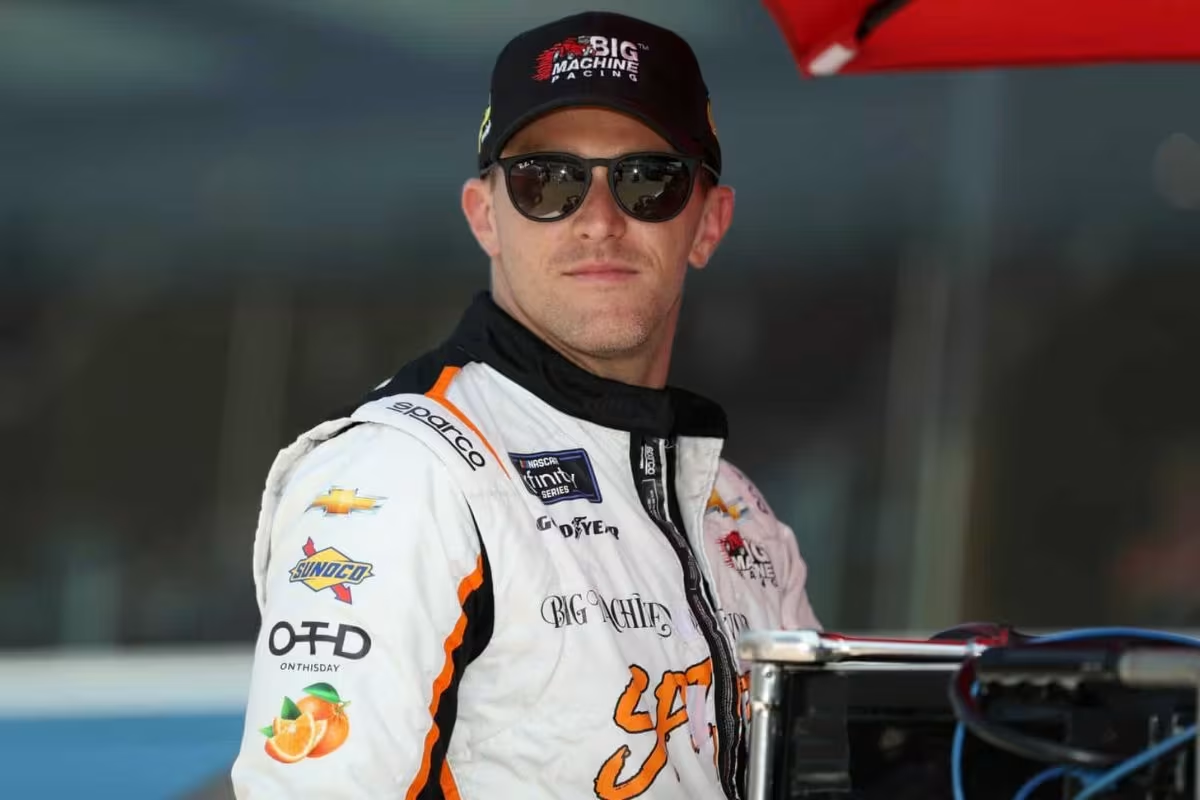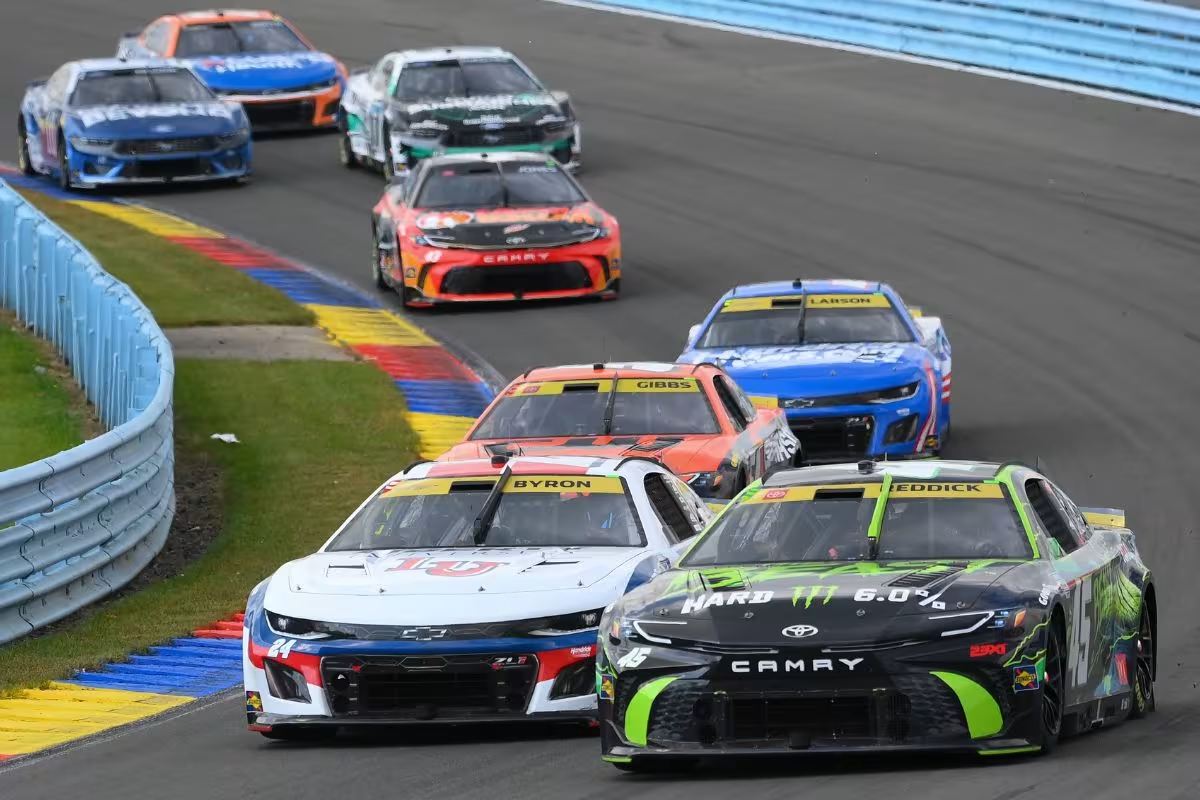Parker Kligerman’s shot at victory at the Charlotte slipped through his fingers in a heart-stopping moment, fueled by NASCAR’s latest officiating fail, that has left fans buzzing. Just feet away from the checkered flag, fate had other plans. What caused this change? And could it have been prevented? As the dust settles, fans are left wondering if this was merely bad luck or if there’s something more behind the chaos that unfolded.
Key Highlights
- NASCAR insider Pockrass criticized the 20-second delay in caution calls during Leland Honeyman’s crash, impacting Parker Kligerman’s race outcome.
- The caution allowed Sam Mayer to overtake Parker Kligerman, denying him a potential victory just five feet away.
- There are ongoing concerns about NASCAR’s inconsistent rule enforcement affecting competitive integrity across various series.
- Parker Kligerman expressed emotional strain post-race, highlighting the mental impact of missed opportunities in racing.
- Calls for improved incident management and clearer communication protocols have emerged to prevent future mishaps and ensure driver safety.
Parker Kligerman’s Missed Opportunity
Parker Kligerman’s missed chance at the Charlotte Roval is a tough reminder of how close and unpredictable success can be in NASCAR. With just five feet between him and his long-awaited victory, Parker Kligerman’s hopes were shattered in an instant, showing how quickly things can change in motorsports.
After racing in 118 Xfinity Series races since 2009, Parker Kligerman was in a great position to finally get his first win. But then, Leland Honeyman crashed, bringing out a late caution that changed everything. This unexpected caution ruined Parker Kligerman’s momentum and altered the race’s outcome.
As the caution flag waved, the excitement around Parker Kligerman’s likely win faded. His No. 48 team, who were ready to celebrate, was suddenly in shock as the situation changed in an instant.
When the race restarted, Sam Mayer took advantage of the chaos and passed Parker Kligerman, stealing what could have been his big victory.
Parker Kligerman’s performance throughout the race was impressive, showing his skills and determination, but the late caution was a tough reminder of how quickly things can go wrong in NASCAR. It also raises questions about how caution flags are managed, especially in the most crucial moments of a race.
NASCAR’s Questionable Decision
The recent incident involving Parker Kligerman at the Charlotte Roval highlights a broader pattern of questionable decisions by NASCAR that have sparked frustration among insiders and fans similarly. This situation is representative of a deeper issue within the organization, where executive decisions have come under increasing scrutiny.
The inconsistency in rule enforcement is particularly troubling, as evidenced by the contrasting treatment of drivers in similar situations, raising concerns about fairness and transparency. For example, Ryan Blaney and Josh Berry were deemed ineligible to continue racing at Watkins Glen and Kansas, respectively, due to their inability to move their cars.
However, NASCAR’s decision to tow Chase Elliott‘s car at Talladega, while leaving over twenty wrecked Cup cars unattended, indicates a troubling inconsistency in their application of rules. Such contradictions not only undermine the integrity of the sport but also erode trust among competitors and fans.
The consequences extend beyond the Cup Series, as the Xfinity Series has also been blemished by questionable calls, most notably when Parker Kligerman was denied a rightful victory. This pattern suggests a systemic issue within NASCAR’s decision-making processes, necessitating a reevaluation of their protocols to guarantee that fairness prevails.
Bob Pockrass’s Criticism of the Caution Delay
There is a growing concern among NASCAR insiders regarding the delays in caution calls, particularly highlighted by Bob Pockrass’s recent critique of the caution delay during the incident involving Leland Honeyman at the Charlotte Roval.
Bob Pockrass’s comments emphasize a critical deficiency in NASCAR’s operational protocols when responding to on-track incidents, especially those that threaten driver safety.
During an interview on the ‘Door, Bumper, Clear’ podcast, Bob Pockrass highlighted that the delay in pushing the caution button was unacceptable. He stated, “Take Parker Kligerman out of it, it shouldn’t take 20 seconds to get a caution for somebody who’s buried in the tires. I mean, now granted, on TV you kind of saw him moving…But if a car gets buried.”
This observation is not merely about the implications for Parker Kligerman, who was on the verge of clinching his initial win; it reflects a larger systemic issue in NASCAR’s response mechanisms.
Freddie Kraft, a member of Parker Kligerman’s team, echoed Bob Pockrass’s sentiment, asserting that Leland Honeyman was not in a position to exit his vehicle, further validating the urgency of the situation.
“He wasn’t getting out of that.” -Freddie Kraft
Bob Pockrass’s insistence that the process must improve speaks to a need for NASCAR to reevaluate its incident management protocols. A delay of even a few seconds can alter race outcomes and, more crucially, jeopardize driver safety.
“Yeah. And so, whatever the process is, it needed to improve.” – Bob Pockrass
NASCAR’s Attempt to Address the Situation
In consideration of the recent criticism, NASCAR has sought to address the concerns surrounding the caution delays by engaging in a thorough examination of their incident management practices. This introspection comes in light of the notable backlash following the botched caution call that overshadowed Parker Kligerman’s potential victory.
“Actually, during or before the Cup race, you can hear them talking to spotters, their officials, and saying, okay. ‘Where can you see, tell me what you can see?’ …I think to make sure that they had the whole track covered.” – Bob Pockrass
NASCAR’s approach to rectifying these issues is multifaceted, aiming to improve both transparency and efficiency in race operations.
- Improved communication protocols among officials and spotters.
- Extensive training for officiating staff on incident management.
- Implementation of a real-time monitoring system for race conditions.
- A review and potential revision of existing caution flag protocols.
- Increased engagement with fans to address their concerns directly.
Despite these initiatives, the effectiveness of NASCAR’s response remains to be seen. The acknowledgment that officials were actively communicating during the race suggests a recognition of the need for improved situational awareness.
However, as Bob Pockrass pointed out, the delay in waving the yellow flag for a vehicle in a precarious position reflects a critical lapse in judgment. This incident has highlighted the necessity for NASCAR to not only react but also proactively refine their operational strategies.
“Wherever Parker Kligerman is or the impact on the race shouldn’t take 20 seconds to throw a caution for a car buried that deep.” – Bob Pockrass
While the steps taken are commendable, the true measure of success will be determined by the organization’s ability to implement these changes effectively and prevent similar controversies in the future.
Parker Kligerman’s Disappointment and Resilience
Parker Kligerman’s experience at the Charlotte Roval represents the profound frustration that can arise from a botched caution call, emphasizing both the emotional toll on drivers and the impact on their performance. After battling fiercely against esteemed competitors like AJ Allmendinger and Shane van Gisbergen, Parker Kligerman’s momentum was abruptly halted mere feet from what could have been a defining victory. His mastery on the track was evident; having navigated the complexities of the Roval with precision, he was poised to capture the checkered flag when the caution flag was unfurled.
The emotional aftermath of this incident is considerable. Parker Kligerman articulated his heartache succinctly, acknowledging the psychological strain of being so close to a win only to have it snatched away. His admission of tearing up during the moment highlights the passion and investment drivers pour into their craft.
“The laps leading up to that were some of the best that I’ve ever driven my entire career, and I just knew I had to be perfect, and I was.” – Parker Kligerman
News in Brief: NASCAR’s Latest Officiating Fail
The controversy surrounding Parker Kligerman’s hampered victory highlights considerable flaws in NASCAR’s decision-making processes, particularly regarding caution protocols. The criticism from insiders, such as Bob Pockrass, emphasizes the need for improved transparency and accountability within the organization. Parker Kligerman’s disappointment reflects a broader sentiment among competitors regarding the integrity of race outcomes.
ALSO READ: So Close, Yet So Far! Parker Kligerman’s Storybook Ending Slips Away in 0.05 Seconds!



